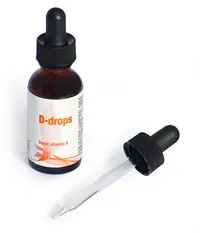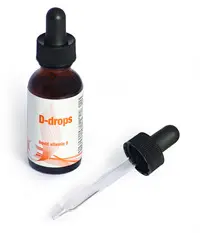D-drops – CaliVita ® 's neue Wunder Vitamin

a correlation has been demonstrated between vitamin D levels and depression?
- in winter the incidence of depression grows?
- tanning beds are not suitable for vitamin D supplementation? With UVA rays emitted by tanning beds our body cannot synthesize vitamin D, only from UVB rays.
Warning.
Do not exceed the daily recommended dose.
Store away from direct sunshine.
Do not apply in the case of hypocalcaemia.
In the case of kidney stones and sarcoidosis, consult your doctor.
In the case of applying any other formula containing vitamin D, consult your doctor.
Bibliography:
• Summary of evidence-based review on vitamin D efficacy and safety in relation to bone health - Cranney A, Weiler HA, O'Donnell S, Puil L., Am J Clin Nutr. 2008 Aug;88(2):513S-519S.
• http://www.hsph.harvard.edu
• 25-Hydroxyvitamin D and Risk of Myocardial Infarction in Men, A Prospective Study - Edward Giovannucci, MD, ScD; Yan Liu, MS; Bruce W. Hollis, MD, PhD; Eric B. Rimm, ScD, Arch Intern Med. 2008;168(11):1174-1180
• Vitamin D regulates steroidogenesis and insulin-like growth factor binding protein-1 (IGFBP-1) production in human ovarian cells - Parikh G, Varadinova M, Suwandhi P, Araki T, Rosenwaks Z, Poretsky L, Seto-Young D., Horm Metab Res. 2010 Sep;42(10):754-7.
• Estimated benefit of increased vitamin D status in reducing the economic burden of disease in western Europe - Grant WB, Cross HS, Garland CF, Gorham ED, Moan J, Peterlik M, Porojnicu AC, Reichrath J, Zittermann A., Prog Biophys Mol Biol. 2009 Feb-Apr;99(2-3)
Do not assume you don’t need vitamin D in the spring.
Nearly 50% of the population of Europe have an inadeqaute vitamin D supply even in months of sunshine. This ratio may rise during winter to 70%-80%.
In a study performed in the summer of 2011, blood donors aged between 20-60 and active, elderly people who regularly partake in sport, were examined. The findings showed that 63% of the people above the age of 43 have vitamin D deficiency and insufficiency, while in young people the result was 41%. These results are shocking as all this happened despite the fact that the study was performed in summer with adults who were healthy and/or do outdoor athletic activities.2 In view of the findings, one can easily imagine the possible results for people who lead a less active lifestyle or struggle with health problems!
So supplementing with vitamin D is also necessary even in spring and summer.
Now let us examine why.
Lifestyle
Having the sun shining outside means nothing if we sit indoors in an office from 8am to 5 pm.
We can gain adequate amounts and quality of sunshine only by regular sunbathing. The ability to be exposed to adequate amounts and quality of sunshine varies according to different time periods, regions. It is important to know that although our skin’s ability to synthesize vitamin D is high, after a certain amount of light the amount of vitamin D will not grow further. So it is better for us not to delude ourselves that during a two-week holiday we can recharge our body with enough vitamin D for an entire year, especially if we spend these 2 weeks with refurbishing our home. And we should not forget about children who spend time indoors in front of computers or TV addiction.
Sun protection creams
Family doctors and dermatologists continue to recommend we protect our skin against the sun’s radiation with adequate clothing and sun protection creams, especially if we are exposed to sunlight continuously such as people working outdoors and children on vacation. However, sun protection creams from factor 8 upwards may decrease vitamin D production by more than 90%, even though they may help reduce the risk of skin cancer.
Age, illnesses, and other characteristics
With the advancement of age, the thinning of skin, the deterioration of vitamin D transforming ability of our kidneys, and the development of illnesses, our body’s ability to produce vitamin D decreases. Fat absorption disorders, a diet lacking in vegetables or fish,being overweight, smoking, lactose intolerance, having a sun allergy, dangerous moles, and darker skin types, may all be a good reason to protect our skins better and may all contribute to the fact that or skin can synthesize less vitamin D from the same amounts of vitamin D.
Improper diet
We do not consume - neither in winter nor in summer - adequate amounts of food containing vitamin D or food enriched with vitamin D. Even experts say that we cannot observe the new recommendations concerning intake in elevated amounts only with diet, as no-one should eat 33 eggs or more than 6 kilos of feta per day.
The solution is simple.
 D drops containing D3, the most effective form of vitamin D extracted from naturally sourced – cod – with
D drops containing D3, the most effective form of vitamin D extracted from naturally sourced – cod – withorange and lemon flavoring is a simple solution for the whole family.
A natural, liquid formula with a drop doser.
Contains no added sugar or sweeteners.
Contains no artificial aromas or colorants.
Ingredients/ 3 drops (approx. 0,1 ml):
Vitamin D3 1200 IU
Attention!
Do not exceed the daily recommended dose!
Keep tightly closed in a cool, dry place away from excessive heat. Do not freeze.
Do not apply it in case of hypercalcaemia!
In case of kidney stones and sarcoidosis consult your doctor!
If you take other formulas containing vitamin D consult your doctor!
Sources:
1 – UN 2005. http://www.un.org/esa/population/publications/WUP2005/2005wup.htm
2 - D-vitamin-ellátottság felmérése Vas megye egészséges véradói körében/ Vitamin D supply among healthy blood donors in County Vas, Hungary – É. Virágh, D. Horváth, Z. Lőcsei, L. Kovács, R. Jáger, B. Varga, G. Kovács L., E. Salamonné Toldy; Orvosi Hetilap 153./vol 41.; 1629-1637, Akadémiai Kiadó 2012















